Sun-drying effectively prevents mold growth through two key mechanisms: ultraviolet (UV) radiation and heat exposure. When you sun-dry items properly, UV rays penetrate mold spores and disrupt their DNA, preventing reproduction. Direct sunlight also creates high temperatures between 85°F-145°F that dry out moisture, which mold needs to survive. You'll need 1-3 hours of exposure for best results, along with good air circulation and humidity levels below 50%. While glass barriers reduce UV effectiveness, proper ventilation and material selection can maximize your sun-drying success. Understanding these elements can help you harness the sun's natural mold-fighting power.
Understanding UV Light Against Mold
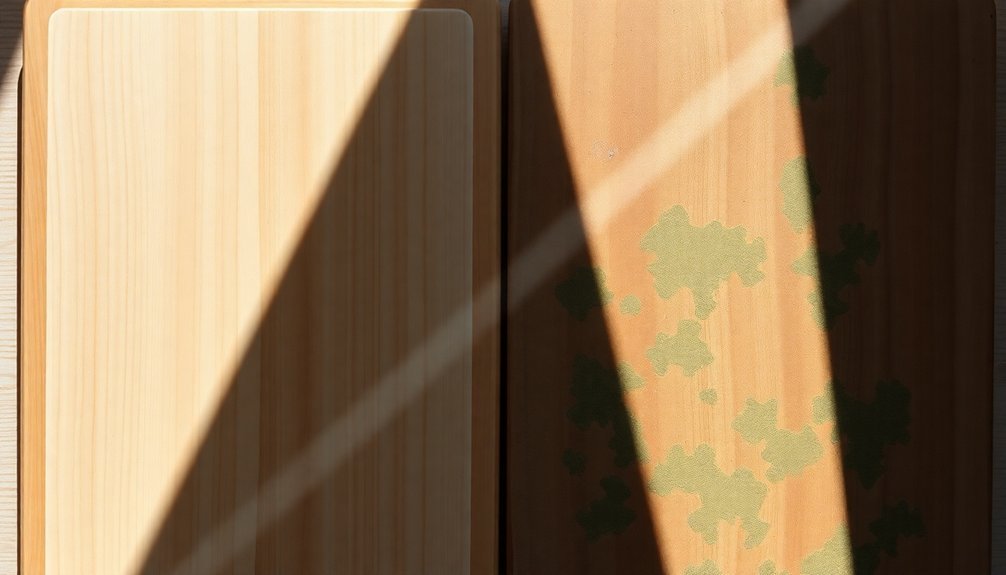
Nearly all effective mold prevention strategies rely on proper UV light application, with UV-C being the champion against fungal growth. When you're dealing with mold, it's essential to understand that not all UV light is equally effective. UV-C light, specifically within the 255-280nm wavelength range, is your most potent weapon against mold spores. For optimal results, UV intensity levels must be carefully controlled.
You'll find that UV-C light works by attacking mold at its core, breaking down its DNA and RNA structures. This process effectively sterilizes the spores and prevents them from reproducing, eventually leading to their death.
What makes UV-C particularly effective is its ability to reach areas that might be difficult to treat with conventional methods, providing a thorough and chemical-free solution to your mold problems.
While UV-A and UV-B lights might seem like viable alternatives, they won't help you combat mold growth. In fact, UV-B can be harmful to your health.
The intensity of UV-C light plays a significant role in its effectiveness – the stronger the light, the more efficiently it'll destroy mold spores. This understanding forms the foundation for successful mold prevention through proper sun-drying techniques.
Natural Sunlight's Mold-Fighting Properties
The remarkable power of natural sunlight stands as your first line of defense against mold growth. When you expose moldy areas to direct sunlight, you're actually deploying a powerful natural disinfectant that works in multiple ways to combat fungal invasion. The sun's UV rays, particularly UV-C, directly damage mold cells' DNA, preventing them from reproducing and eventually killing them.
You'll find that sunlight's effectiveness comes from its dual-action approach. First, it creates an inhospitable environment by drying out the moisture that mold needs to thrive. Second, its UV radiation disrupts the mold's cellular structure. Research shows that direct sunlight exposure for just 1-3 hours can effectively stop mold from reproducing.
When you're dealing with damp spaces in your home, you can harness this natural power by opening curtains and blinds, especially in moisture-prone areas like bathrooms and basements.
If you've got portable items affected by mold, take them outside on sunny days. The sun's heat and UV rays will help eliminate surface mold while preventing spores from spreading.
Remember that while sunlight's a powerful tool, it works best when combined with proper ventilation and humidity control, as it can't penetrate deep into porous materials.
Optimal Sun Exposure Times
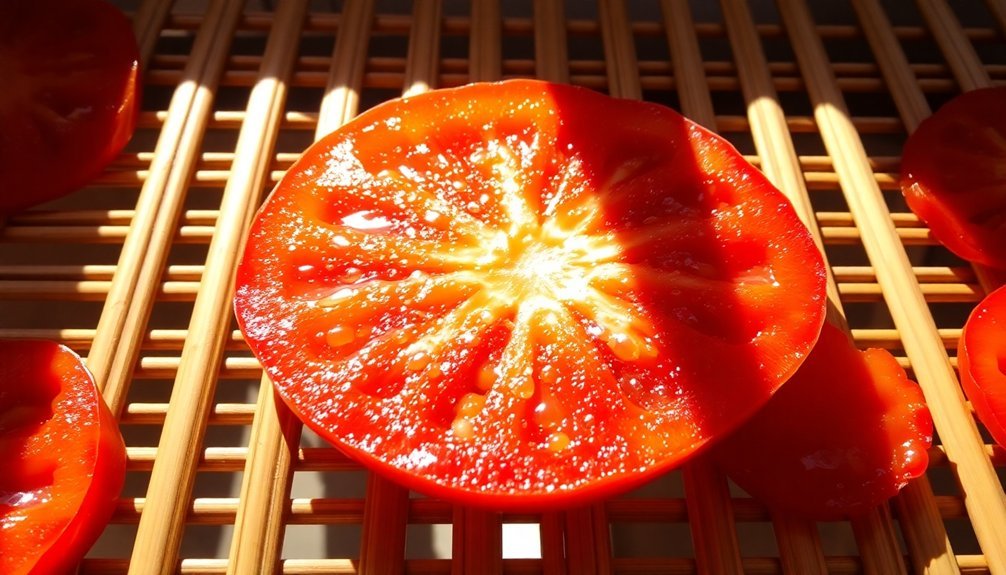
Successfully eliminating mold requires precise timing when using sunlight as your natural disinfectant. You'll need to expose affected items to direct sunlight for 1-3 hours to stop mold spores from reproducing. For young mold patches, 1-2 hours of continuous exposure will effectively eradicate the problem, though established colonies may require longer treatment times.
You'll get the best results when you combine proper timing with ideal conditions. Direct sunlight works better than indirect light, and you shouldn't place items behind glass windows, as they filter out essential UV rays. Keep in mind that UVA and UVB rays work together to damage mold cells' DNA and prevent reproduction, making outdoor exposure essential. High-temperature drying has proven effective since the 1800s for preventing mold growth.
Remember that environmental factors affect your sun-drying success. You'll want to choose days with low humidity and clear skies, as cloud cover and moisture reduce sunlight's effectiveness.
Don't forget to maintain good airflow around the items you're treating – it helps expel moisture and enhances sunlight's mold-fighting properties. If you're working with a UV forecast, you can adjust your exposure times accordingly, using shorter durations on high-UV days.
Best Practices for Sun-Drying
Building upon proper timing, effective sun-drying demands careful attention to environmental conditions and setup.
You'll need to maintain humidity levels between 30-60% and temperatures between 85-100°F to prevent mold growth while guaranteeing ideal drying conditions. Use hygrometers and thermometers to monitor these vital factors throughout the process.
Position your drying racks to maximize natural airflow, aiming for air speeds of 1-2 mph through your drying chamber.
You'll want to place intake vents low and exhaust vents high to create natural convection. For maximum heat collection, angle your solar collector at 10-15 degrees more than your latitude and consider using reflective surfaces like aluminum foil.
Select uniform, fresh produce without blemishes, and avoid foods high in fat content.
You'll need to protect your drying items with screens or netting, and cover trays with cheesecloth to keep out birds and insects.
Don't forget to elevate your racks for proper air circulation on all sides.
Remember to rotate food items regularly to guarantee even drying, and monitor UV levels since higher readings typically result in faster drying times.
Common Sun-Drying Mistakes
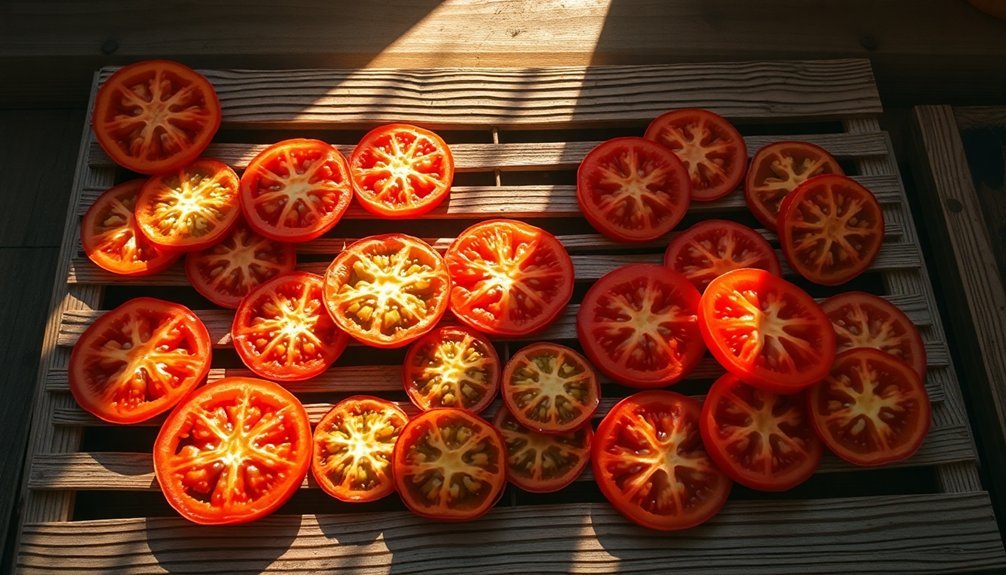
When you're sun-drying produce, restricted airflow can trap moisture and promote mold growth, so it's essential to maintain proper spacing between items and use elevated drying racks.
Your inconsistent drying times, whether too long or too short, won't effectively remove moisture from the food, leading to either over-dried or under-dried products that are prone to spoilage.
You'll need to closely monitor weather conditions, as unexpected rain or high humidity can quickly undo your drying progress and create perfect conditions for mold development.
Poor Airflow During Drying
During the sun-drying process, poor airflow stands out as one of the most critical mistakes you can make. Without proper air circulation, moisture can't escape effectively, creating the perfect environment for mold to thrive.
If you don't allow air to flow freely around your products, you'll end up with stagnant air pockets that trap humidity and slow down the drying process.
To guarantee proper airflow, you'll need to place your items on trays with enough space between them. Don't forget to turn your products occasionally – this helps achieve even drying and prevents moisture from getting trapped underneath.
If you're using a solar dryer, you'll benefit from enhanced air circulation and sun exposure, which can greatly reduce drying times.
Remember that ventilation needs to be controlled based on your climate. In humid conditions, you'll want to be strategic about air circulation to prevent bringing in more moisture.
You should aim to keep relative humidity below 50% to prevent mold growth. If you're drying during nighttime hours, make sure to shelter your products to maintain ideal drying conditions and prevent moisture from settling back into your items.
Inconsistent Exposure Times
Maintaining consistent exposure times marks an essential factor in successful sun-drying, yet many people underestimate its importance. When you're sun-drying items, you'll need to guarantee 1-3 hours of direct sunlight to effectively stop mold spores from reproducing. If you're dealing with established mold, you'll need even longer exposure times.
You can't expect the same results on cloudy days or when sunlight filters through glass, as these conditions lack the necessary UV rays to kill mold. If you're in a humid climate, you'll need to adjust your drying times accordingly, as moisture in the air can counteract the sun's effectiveness. Different types of mold also require varying exposure times, with some being more resistant than others.
To maximize sunlight's mold-killing potential, you'll want to take items outside on sunny days and position them for direct exposure. Remember to rotate items regularly to guarantee even exposure, and don't forget about proper ventilation.
When handling moldy items, always protect yourself with gloves and a mask. By maintaining consistent exposure times and following these practices, you'll greatly improve your sun-drying success rate.
Ignoring Weather Conditions
Weather awareness plays an essential role in successful sun-drying, yet many people overlook these important conditions. If you're not monitoring the temperature, you'll risk incomplete drying since temperatures below 98°F won't effectively evaporate moisture. Higher temperatures are ideal for quick drying and preventing mold growth, but you'll need to watch for fluctuations that can compromise the process.
Humidity levels are just as important as temperature. You'll want to make sure the humidity stays below 60% for effective moisture removal. If you're in a high-humidity region like the South, you might face challenges with proper drying, as excess moisture in the air can slow down the process and create perfect conditions for mold growth.
Don't forget about air circulation – it's your key defense against mold. You'll need consistent airflow to remove moist air around your food. Consider using solar dryers with proper ventilation, and arrange your drying trays to allow air movement both above and below.
While you're monitoring these conditions, be certain you're protecting your food from contaminants by using screens or cheesecloth, and always bring your items inside at night.
Material Selection for Sun-Drying
When you're choosing materials for sun-drying, opt for non-porous surfaces like concrete, cement, or black plastic sheets that efficiently absorb solar radiation and prevent moisture retention.
You'll get the best results by painting concrete surfaces black or using matt black materials, which can reduce drying time by up to 15% compared to unpainted surfaces.
For items that need air circulation, use stainless steel or Teflon-coated fiberglass screens elevated on blocks, as these materials won't react with food and allow proper airflow while keeping the items off direct ground contact.
Best Materials for Sunlight
Choosing the right materials for sun-drying is essential to guarantee food safety and ideal drying results. When selecting screens and mesh, you'll want to prioritize stainless steel or Teflon-coated fiberglass options, as they're safest for food contact.
Avoid using galvanized metal, copper, or aluminum screens, which can oxidize and contaminate your food.
For frames and structures, opt for untreated wood or food-grade stainless steel. These materials should be durable enough to withstand outdoor conditions while maintaining proper sealing to keep out pests and dust.
If you're working with larger units, consider adding small fans to improve air circulation.
You can boost drying efficiency by incorporating reflective surfaces like aluminum foil or mirrors beneath your drying racks. Just make certain these surfaces don't directly contact the food while positioning them to maximize sunlight reflection.
For protective layers, use cheesecloth or similar breathable materials to shield your food from insects while allowing proper air circulation.
When using translucent covers for delicate foods, make sure they protect against harsh rays while still permitting adequate moisture removal.
Non-Porous Versus Porous Items
Understanding the difference between porous and non-porous materials is crucial for successful sun-drying practices. When you're selecting items for sun-drying, non-porous materials like plastics and metals offer significant advantages. They're easier to clean, dry quickly, and don't retain moisture that could lead to mold growth. You won't need to worry about structural damage since these materials maintain their shape during the drying process.
Porous materials present more challenges for sun-drying. They absorb and hold water, making them susceptible to mold infiltration and slower drying times. You'll need to be particularly careful with items like wood and drywall, as they can warp or crack during drying.
| Material Type | Drying Speed | Mold Risk |
|---|---|---|
| Metal | Fast | Low |
| Plastic | Fast | Low |
| Wood | Slow | High |
| Drywall | Very Slow | High |
To maximize your sun-drying success, prioritize non-porous items whenever possible. If you must dry porous materials, you'll need to monitor them closely and guarantee complete drying to prevent mold growth. Remember that capillary effects in porous materials can trap moisture, making thorough drying more challenging and time-consuming.
Weather Conditions for Effective Drying
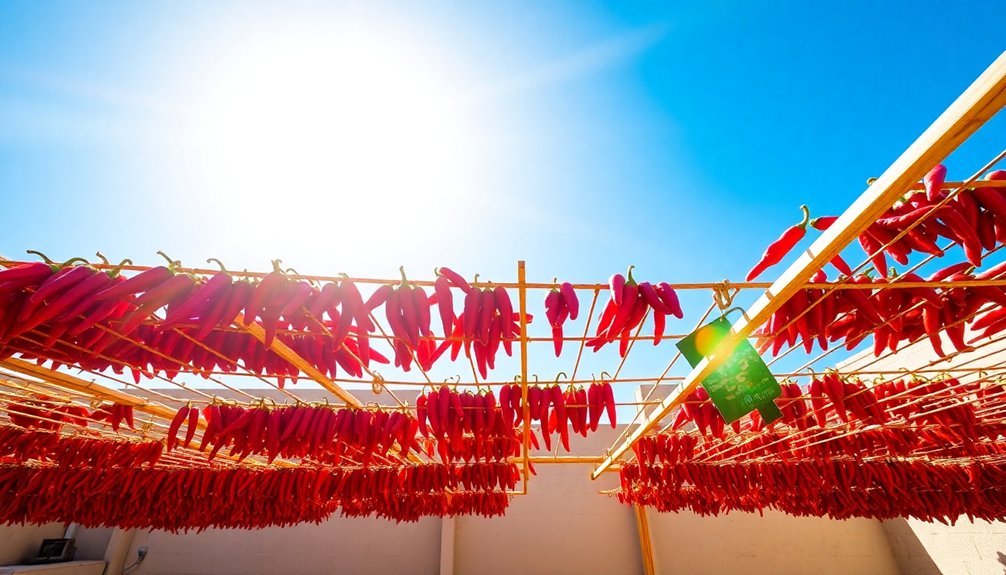
Successful sun-drying hinges on specific weather conditions that work together to prevent mold growth.
You'll need temperatures between 85°F and 145°F (29°C-62°C) for ideal drying, with solar drying capable of raising temperatures up to 33°C above ambient conditions. If grain temperatures exceed 50-60ºC, you'll need to cover them to prevent overheating.
You'll achieve the best results when humidity stays below 60%, ideally between 30-60%. Keep a hygrometer handy to monitor these levels, as high humidity can cause rewetting and grain cracking, leading to mold formation.
Position your drying racks where they'll catch prevailing breezes, aiming for air speeds of 1-2 mph through your drying chamber.
For maximum sun exposure, place your racks in open areas away from shadows, preferably on south-facing slopes. You can boost sun exposure by up to 25% using reflective surfaces like aluminum foil or mirrors.
If you're drying delicate foods, use translucent covers to protect them while maintaining effective drying conditions. Remember to elevate your racks and create natural convection by placing intake vents low and exhaust vents high.
Natural Alternatives During Cloudy Days
On cloudy days when sun-drying isn't feasible, you'll need natural alternatives to prevent mold growth.
Start by using a vinegar solution, mixing equal parts water and vinegar in a spray bottle. Apply this mixture to your items and let it sit for an hour before scrubbing to effectively combat existing mold and prevent future growth.
You can also create a baking soda paste by mixing it with water. This natural remedy not only fights mold but also absorbs excess moisture that could lead to future mold problems.
For fabrics, soak them in a solution of either vinegar or baking soda before drying indoors.
Consider using essential oils as powerful natural antifungal agents. Add a few drops of tea tree oil to water in a spray bottle, or try grapefruit seed extract, peppermint, or cinnamon oils for their mold-fighting properties.
While your items dry indoors, make certain proper ventilation by running fans and dehumidifiers. Place moisture-absorbing houseplants like peace lilies or English ivy nearby to help reduce humidity levels.
Remember to declutter the drying area to improve air circulation, which greatly reduces the risk of mold development.
Frequently Asked Questions
Can Excessive Sun Exposure Damage or Fade Materials While Killing Mold?
Yes, you'll find that UV radiation kills mold effectively but can also harm your materials. It'll cause fading, yellowing, and break down polymers, leading to weakened structural integrity and aesthetic damage over time.
Does Sun-Drying Effectively Eliminate Existing Mold Colonies Beneath Surface Layers?
No, you can't eliminate deep mold colonies through sun-drying alone. While UV rays effectively kill surface mold, they won't penetrate porous materials to reach colonies growing beneath the surface. You'll need additional treatment methods.
How Do Different Colored Materials Affect Sun-Drying's Effectiveness Against Mold?
You'll find dark materials absorb more heat but risk overheating, while light colors reflect sunlight for cooler drying. Transparent covers let UV rays through, and reflective surfaces boost exposure by up to 25%.
Are There Specific Humidity Levels Where Sun-Drying Becomes Ineffective?
You'll find sun-drying becomes ineffective when humidity rises above 60%. Your drying process won't work well in 80%+ humidity, as moisture can't evaporate properly, creating perfect conditions for mold growth.
Can Moonlight or Starlight Contribute to Preventing Mold Growth?
No, you can't rely on moonlight or starlight to prevent mold growth. They don't contain the UV rays needed to kill mold spores or reduce moisture levels like sunlight does.
In Summary
Sun-drying effectively prevents mold when you follow the right techniques. You'll get the best results by exposing items to direct sunlight for 4-6 hours during peak UV hours, maintaining proper airflow, and ensuring materials are completely dry before storage. If you're dealing with cloudy days, you can use alternatives like dehumidifiers or well-ventilated indoor spaces. Remember, consistent monitoring and proper timing are your keys to mold-free results.

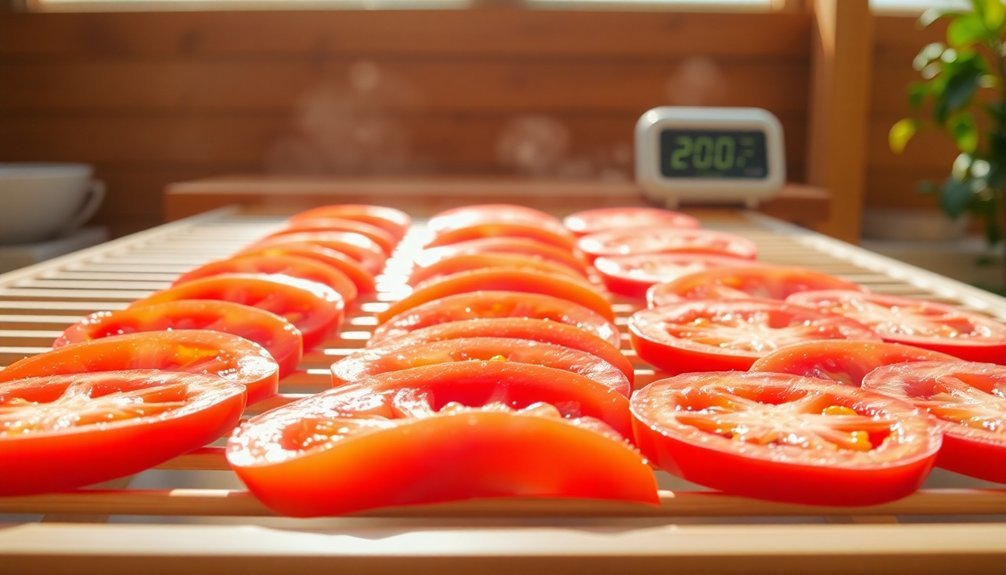



Leave a Reply